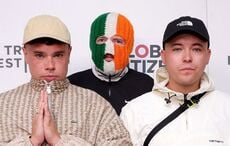In "Kill the Irishman," the by turns hilarious and terrifying portrait of the Irish American man who brought down the mafia, Ray Stevenson gives an unforgettable portrait of an unhinged underdog whose near insanity turns the crime world upside down. Cahir O'Doherty talks to the principals involved in the riveting film.
People who have nothing to lose are the most dangerous people of all. Having grown up knowing they matter to no one, they can take it into their heads that nothing else matters either.
In the new film "Kill the Irishman" we meet one such desperate man in the shape of Danny Greene (played by 46-year-old Lurgan, Co. Armagh-born Irish actor Ray Stevenson) the Irish American working class Cleveland boy who, despite the odds stacked against him, is determined to make a name for himself in the world.
Greene’s debut is literally explosive. In the summer of 1976, when "Kill the Irishman" is set, no less than 36 bombs explode in Cleveland as a turf war he set off rages between himself and the mob.
Now most betting people would give the advantage to the mob, and that’s why this film is so powerfully fascinating -- the mob loses.
Incredibly, "Kill the Irishman," which opens this Friday, March 11, is based on the true story of how a fearless Irish American boy turned the tables on the famous loan shark Shonder Birns (played by a delightfully exasperated Christopher Walken) and stopped taking orders from the capos, instead striking out on his own power trip.
Greene’s enemies discover he has an almost Road Runner-like ability to evade certain death, and it begins to unnerve them all.
"Kill the Irishman" isn’t just the film’s title; it’s the increasingly angry command from the crime bosses. Soon they begin to suspect he’s getting supernatural help and his legend is born.
But where does a man like Danny Greene, who studied Irish history voraciously and insisted that all his associates do the same, come from? In the film the answer is simple -- he comes from a predominantly Italian neighborhood where, between the ages of 12 and 16 he had a fistfight with the neighbors every single day.
“He was an underdog in a town full of them,” says Jonathan Hensleigh, the film’s writer and director (known for his work on "Die Hard: With A Vengeance" and "Jumanji.")
“Irish people are the only ones who see the deep connection between Danny Greene’s tough upbringing, where he lived his life every day like he had nothing to lose and the terrifying casualness he had about life and death later on.”
Greene wore green clothes, drove green cars, and hung a green crucifix around his neck. It was as if he wanted to bamboozle his enemies by being Irish on stilts.
A former marine, he was polite to a fault. It was “yes sir” and “no sir” until you looked in his eyes and saw a man who would ruthlessly coerce you at the merest sign of resistance.
Because Greene saw himself as the ultimate underdog who had been abused and exploited by others in his own community out to line their own pockets, he took a special shine to Irish history because, with its narrative of invasion and exploitation, in a way it mirrored his own.
“Did he get into all this Celtic warrior stuff? Not so much. It was more a case of seeing how the Irish had thrown off their oppressors. He enjoyed that,” says Hensleigh.
The Irish weren’t powerful, but they had smarts. It’s why Greene made his honchos read Irish history books.
Somehow Greene managed to survive all the countless assassination attempts made by the mob, and he bumped off anyone who went after him in retaliation. But it was Greene’s utter fearlessness that mystified his enemies, and misjudging him at every turn eventually led to the collapse of the mafia syndicates across the U.S., earning Greene the title of the man the mob couldn’t kill.
Stevenson, most famous for his electrifying performance as Titus Pullo in HBO’s "Rome," agrees that Greene drew inspiration from Irish history.
“He used his own money to subsidize the education of orphans, he bought 50 turkeys for the poor on Thanksgiving and Christmas Day. But if he found a way to help and at the same time stick it to his enemies, he’d go that route instead. He was a gangster, he wasn’t Robin Hood,” Stevenson told the Irish Voice.
Hensleigh says that in researching the life of his subject he was amazed, time and time again, by the conflicting aspects of Greene’s character.
“Look, this guy was a murderer. The film is not suggesting he was a hero. But we do strike a balance between the things he did for people. He’s a complex, multilayered individual and the film brings that out.”
Moviegoers unfamiliar with Greene’s life and legacy might not be aware of how pitch-perfect Stevenson’s performance actually is. The surface details are all exactly like the real man’s right down to the thinning hair, the handlebar mustache, and the groovy 1970s shirt collars.
But Stevenson goes far beyond the surface details in an indelible performance that will amaze you. One moment you find yourself rooting for him, even cheering, and the next you want to see him locked away for life.
“Each of the actors in this film are lead actors, but there’s no scene-stealing going on. I was amazed by the style and the skill I saw all around me. It was a real collaboration between everyone involved,” says Stevenson.
"We didn’t tell the story like a documentary; we looked for the truth of this journey and this world. If you believe in this journey then my job is done.”
Shonder Birns’s niece introduced herself to Stevenson at the film’s premiere in Palm Springs last week, which made him realize how close in time the film was to the actual events.
“This man brought down the five main mafia families and they never recovered from it. So it was strange to meet her in that sense. We’re doing a screening in Cleveland next, and I’m a little concerned about how it will go, to be honest!” said Stevenson.
Shooting the film on the mean streets of Detroit as a stand-in for Cleveland was a major eye-opener for Stevenson.
“Our film trucks got shot at and had eight bullet holes in them. We saw a man get shot in the neck near the projects and he had to wait for 40 minutes before the ambulance arrived,” he said.
“Then they had to wait 40 minutes for the cops to arrive for an escort to pick him up. The people in the projects didn’t want him to survive. That was the kind of daily event there that blew my mind.”
In the role of Greene, Stevenson says he knew he was dealing with the fact that everywhere his character went, people had a preconceived opinion of him. He’d always been an underdog and it could be quite isolating and lonely. He had to live on his own all the time.
Says Stevenson, “But he wasn’t altruistic, he wasn’t a Robin Hood figure either. He did things here and there to make some people happy and to piss others off.”
Read more: New movie ‘Kill the Irishman’ takes a look at Cleveland’s mob history - SEE VIDEO




Comments